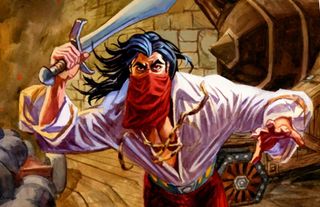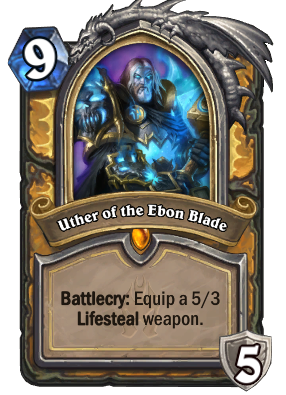Why aggro is good for Hearthstone (honest)
Players are always clamoring for a control meta, but should we be careful what we wish for?

Every time a new Hearthstone expansion is announced, the same questions start floating around: will the meta finally slow down? Might we even be about to see the fabled control meta? After months of playing against refined, brutally aggressive decks, beleaguered players start fantasizing that the new set’s late game bombs and anti-aggro answers might finally lead to slower, more thoughtful matches.
On this front, Knights of the Frozen Throne looked especially promising. Along with a stampede of Druid decks, it introduced Lifesteal, a mechanic which seems tailor-made to counter aggro, as well as the new Death Knight cards, which are tailor-made for longer games. If any expansion could finally muzzle aggro, surely it would be the Frozen Throne. And for a while it did, but more because everyone wanted to take Death Knights out for a spin at first.
But with the meta finally starting to solidify—again, with Druid firmly at the top—aggro is making a comeback. And you know what? I’m glad. Aggro is good for Hearthstone. Two weeks of playing experimental control mirrors was all the convincing I needed, but to really pin down why face will always be at least partly the place, I reached out to a few professional Hearthstone players.
Controlling control
"Aggro benefits Hearthstone like it does all card games," says James 'Greensheep' Luo, a player for Gosu Crew. "It prevents decks from focusing solely on the late game and disregarding early game removal and pressure. Even if a deck can win the game if it draws, say, 80 percent of its cards, it will also have to play cards in order to survive due to the threat of losing to aggro. Aggro is essential for a balanced game."

The high-cost Death Knight hero cards theoretically promote slower, more controlling play.
It can be frustrating to lose to an aggro player who does nothing but hit your face with weapons and Charge minions, but in the same vein, nobody wants to lose to someone who simply stuffs their deck with eight-drops. Actually, that would be even worse, because at least aggro decks have the courtesy to end games quickly.
Greensheep’s stance also highlights out how important anti-aggro cards are, and by extension, how important the existence of aggro is to making their payoff feel worthwhile. Look at the anti-aggro cards introduced in Knights of the Frozen Throne. Cards like Spirit Lash, Corpsetaker, Defile and Spreading Plague are at their best and most exciting when used against aggro, the latter of those having just been hit by the nerf bat. The same is true of Death Knights like Uther of the Ebon Blade and Frost Lich Jaina, whose Lifesteal can totally swing games. Without aggro to quash, those cards lose much of their appeal.
If you don’t have an aggressive push anywhere, what does the game turn into? Who can get to their 10-mana cards and play them in the right order?
—ThatsAdmirable
"If you don’t have an aggressive push anywhere, what does the game turn into?" asks Hearthstone player and caster Nathan ‘ThatsAdmirable’ Zamora. "Who can get to their 10-mana cards and play them in the right order? That doesn’t sound like a fun game to me. Aggressive decks are important because there are people who enjoy playing aggressive decks. There are times when people just want to get into quick games, finish their [daily] quest and feel like they’re making progress with their account. And there are times when aggressive decks are the counter to greedier decks. It all balances out in the end."
The biggest gaming news, reviews and hardware deals
Keep up to date with the most important stories and the best deals, as picked by the PC Gamer team.
The art of face
Aggro is clearly important to the overall health of a CCG, so why does it get such a bad rap? Well, aggro decks are often more concerned with the opponent’s life total than the state of the board. Blizzard insists that interesting interactions between cards make Hearthstone fun, and most players would agree. It can feel like aggro decks that rule and blindly focus on ending games as quickly as possible, so it’s only natural that players resent the strategy. But is aggro really as brainless as it sounds?
In a sense, yes. "It is logical that aggro decks are easier to play," says Peter "Gaara" Stevanovic, one of Tempo Storm’s players. "Aggro decks focus on ending the game as fast as possible, preferably before turn seven, and control decks want to drag out the game. So slower control decks have way more decisions to make on average, which means more room to outplay your opponent or to misplay."
With aggro, I feel every decision impacts the game a lot more than if I were playing a control deck.
Greensheep
But that’s not necessarily the whole story. "People may think that aggro is easier to play since the game plan seems very linear: go face and win," Greensheep says. “But with aggro, I feel every decision impacts the game a lot more than if I were playing a control deck. With aggro, you play the game on a timer. If a game goes too long, you will lose, so you have to use your resources in a certain manner to maximize damage and end the game as fast as possible.”
Admirable is of a similar mind. “Some of the most interesting games I’ve seen happen to be aggressive mirror matches," he says. "A lot of times in those matchups, it comes down to who has the last resource. All of your cards line up evenly and it’s very difficult to get an aggressive push versus someone else who’s trying to do the same thing, so you see players who make better use of their resources come out way ahead."
Playing with or against aggro generally makes for shorter games. This means players will see less of their decks and spend less mana, which results in fewer and narrower decisions. But the stakes are so high that properly navigating those early turns can be difficult. It’s not that aggro isn’t reliant on skill, but that it relies on a different skill set.
Who really wants a pure control meta?
On top of the benefits to aggro existing, there are also major downsides to a control-only meta. "In the past, I would have liked to see a control meta, but not anymore," Gaara says. "The game wouldn’t be healthy because of cards like Drakonid Operative, Elise the Trailblazer and Kazakus. Games would be decided by random value-generating cards."
This is a key point. Nowadays, perfectly identical control decks can face off and play 10 different randomnly-generated cards each. Think about the average Control Paladin mirror. Barring a rare aggressive opener or blowout Equality, the player with more late game threats usually wins. And the player with more late-game threats is usually the one who pulled an extra Tirion Fordring or two off of Stonehill Defender. You can make efficient use of your hero power and save your board clears as much as you want, but sometimes you’ll just get out-valued by RNG, and there’s no skill in that.
This is to say nothing of the most obvious drawback to a slower format: the games are literally slower. Every player I spoke with would hate to see all games drag on for 30-plus minutes, especially in tournaments. That would seriously hinder event planning and the viewing experience, and it would seriously annoy casual players who just want to pop in for some quick fun. After all, very few people want every game to go into fatigue.
Love it or hate it, aggro makes Hearthstone healthier. It keeps control decks honest by preventing them from going full greed, and it makes card design more interesting. Just as importantly, it keeps Hearthstone approachable. Without aggro, it would never have garnered 70 million players. Besides, aggro gave us this video, and I think that’s a good trade:

Austin freelanced for PC Gamer, Eurogamer, IGN, Sports Illustrated, and more while finishing his journalism degree, and has been a full-time writer at PC Gamer's sister publication GamesRadar+ since 2019. They've yet to realize that his position as a staff writer is just a cover-up for his career-spanning Destiny column, and he's kept the ruse going with a focus on news, the occasional feature, and as much Genshin Impact as he can get away with.
Most Popular

